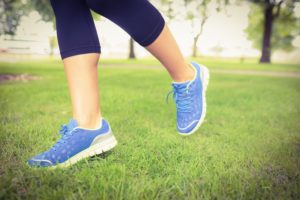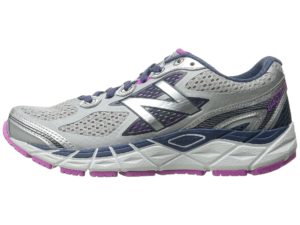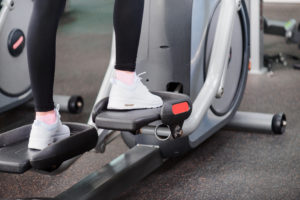Posted by slomotionshoes | 27 June, 2016
Getting Back to Walking After Injury
For runners and walkers alike, there’s nothing worse than trying to recover from an injury. The mind believes it can pick up where it left off before the injury, but the body says “no, not yet!”
“You gotta crawl before you walk” is a popular phrase to use for a person who needs to slow down and not get too far ahead of themselves. This phrase is appropriate for runners and walkers as well because walking can be a play an important part in their road to recovery.
Walking is one of the simplest and easiest forms of exercise, but it can be a challenge if recovering from an injury. With that said, there are many things a person can do to make their walking experience less painful or challenging.
Mind Your Walking Surfaces:

Walking is easier on the joints than running, but if a person has an ankle, knee or foot injury, it can be problematic as well. As a person recovers from injury (or wants to avoid one,) it’s wise to choose a walking surface that’s flat, firm and not too hard:
Grass. Grass is the most natural surface for walking. Well-manicured grass is ideal. Avoid grass that’s uneven or has potholes.
Dirt. Many of the world champion runners from Kenya train on dirt tracks. These surfaces are relatively easy on the joints, but should be avoided after a rain because they may be slippery.
Track. Many high schools have a 400 meter track, and even though they are primarily for runners, the surface is great for walkers.
Sand. Hard sand can be a great walking surface because it’s not too stressful on the joints. On the other hand, soft sand can be hazardous because of its lack of stability and hidden potholes.
Asphalt and Concrete. Most of these surfaces (sidewalks) are flat and straight, which is ideal for walkers. However, they lack cushion and can be difficult on the joints. Softer surfaces are a better option but may not be available in certain areas. In these instances, additional precautions may need to be taken, which will be discussed in the next section.
Choosing the right surface can go a long way for walkers either recovering from injuries or for those seeking to prevent them. In addition to running surfaces, other factors walkers should be aware of include the types of shoes they choose to wear, braces, and orthopedic devices.
Choosing the Right Accessories:

In addition to running surfaces, having the proper equipment is critical. There are many products to choose from, and knowing which to use could be the difference between a speedy recovery or aggravating an existing injury.
Footwear. The ideal shoe for a walker will depend on several factors:
- What type of support is needed? (More support may protect the foot from additional injury)
- What king of surface do you mostly walk on? (Asphalt, trails, grass)
- Do you wear orthotics or any type of ankle support?
Getting assistance from a store associate may help prevent the purchase of the wrong shoe. Also, consider waiting until the end of the day to purchase shoes because feet can be slightly larger by the end of the day. Other things to keep in mind include the following:
- Wear the same type of sock to try on that will be worn while exercising.
- Try several shoes on before making a final decision.
- Allow approximately ½ inch between the end of the toe and end of the shoe.
- Opt for lace-up shoes to ensure the shoes stay on the feet securely
- If braces or orthotics are needed, ensure that the shoe is ”orthotic friendly:” (the insert fits comfortably into the shoe without squeezing the feet.)
- Another cause of injury is wearing shoes that are worn out from overuse and have lost their support and cushion. An option is to purchase two pair of the same shoe and rotate them. This will extend the life of the shoes.
Compression. Compression socks were first made popular by marathon runners and elite athletes. Walkers returning from injury can benefit from these accessories as well:
- Calf length compression socks have been proven to limit swelling.2
- Compression socks worn after a workout may increase the blood flow back up to the heart, thus speeding up recovery.3
Compression socks should be comfortable and should provide 22-32mmhg of pressure.3 They should also fit snug around the feet and ankles and loosen above the calf and towards the knees.
Braces. According to Michael Behr M.D, an orthopedic surgeon at Piedmont, there are several reasons to wear a knee or ankle brace:4
- Pain relief
- Structural relief
- Provide support to weak ankle joints
- Help reduce future injuries
Knee braces are often prescribed by doctors for individuals who have an injury such as a torn ACL or other type of knee injury. Ankle braces are often used by individuals who are prone to ankle sprains or need to keep the ankle stabilized.
Walking Alternatives:

Walking is a great exercise to help a person regain fitness after an injury, but it is not the only option. There are other low impact exercises available that offer great benefits as well:
Stationary bike. Riding a stationary bike is an option for individuals who have trouble putting any pressure on their knees, ankles, or hips. The stationary bike can strengthen the joints and tendons in the knees as well as increase flexibility and range of motion.5
Note: When riding a stationary bike, it should be set in an easier gear to prevent any undue strain on the knees and lower back.
Elliptical. The elliptical is a useful cross training tool for walkers because it is a low impact exercise. It uses the same muscles of walking minus the impact. According to the American Council on Exercise, “people who are particularly prone to lower leg problems from running long distances should consider incorporating low impact activities such as elliptical training.”6
Note: When walking, a person can adjust their stride, but when on an elliptical, a person must do the machine’s stride, which may not match a person’s body mechanics. Another caveat is the possibility of decreased circulation in the feet and ankles. It is advised a person test an elliptical at a slow to moderate pace for ten minutes or so to ensure comfort.
Swimming. Swimming is a popular rehabilitation exercise for injured athletes. The water provides heavy resistance but there is no stress on the joints. Participants can increase their cardiovascular endurance without the risk of injury or aggravating an existing ailment.
Recovering from an injury takes time and patience. Trying to do too much too soon could aggravate an existing injury and make things worse. Walking and other similar low impact exercises can help a person strengthen the affected areas and improve their fitness levels simultaneously. By taking the proper precautions and using the correct products, a person can increase their chances for a full recovery and resuming their pre-injury fitness programs.
Sources:
1http://www.footandankleassoc.com/blog/post/wearing-the-wrong-fitting-running-shoe-can-cause-serious-injury.htm
2http://www.ncbi.nlm.nih.gov/m/pubmed/15099316/
3http://blog.walkjogrun.net/2014/04/07/do-compression-socks-really-work/
4http://www.piedmont.org/living-better/when-are-knee-braces-helpful
5http://www.livestrong.com/article/295352-are-stationary-bikes-good-for-knee-rehab/
6http://www.livestrong.com/article/124083-elliptical-training-runners/

